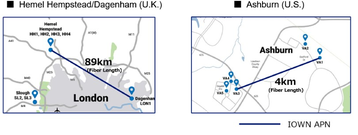NTT has conducted low-latency data center-to-data center light-based photonics tests in the UK and US, claiming latency of less than 1 millisecond between facilities almost 90km apart.
NTT Corporation and NTT DATA Group Corporation this week announced they have demonstrated IOWN All Photonics Network (APN) connections between NTT Group data centers in the United States and the United Kingdom.
In the UK, two data centers around 100 km apart communicated via IOWN APN connection with a round trip of 1 millisecond or less. Similar performance was recorded in the US.
IOWN – Innovative Optical and Wireless Network – encompasses NTT’s light-based All Photonics Network. The company says its APN achieves ultra-low power consumption and ultra-high-speed processing by assigning wavelengths to each function on a single optical fiber.
NTT said the links make multiple data centers functional as an integrated IT infrastructure logically equivalent to a single data center. This enables customers to meet their needs in use cases where low delay is highly required, such as real-time AI analysis and in the finance sector.
IOWN APN can provide the connection line by adding wavelength without installing new dark fiber, which can speed connection roll-outs.
NTT demonstrated its applicability to distributed real-time AI analysis and the financial sector. The company said it plans to conduct business demonstrations with customers and foster early deployment of our data center business with IOWN APN.
In the UK, HH2 in Hemel Hempstead and LON1 in Dagenham (around 89km) were connected, while in the US, VA1 and VA3 in Ashburn (around 4km), were connected using NEC APN equipment to measure round-trip delays and delay jitter between the data centers.
In the UK, both data centers were connected with a delay of less than 1 millisecond (around .9ms) and jitter of less than 1 microsecond at 100Gbps and 400Gbps. The company said the same connection via traditional fiber would see a 2-millisecond delay. Cloud providers often require data centers within given cloud regions to have less than 2ms delay between one another. In the US, the 4km delay saw less than 0.06ms.
NTT’s notes building new facilities in urban areas is becoming increasingly difficult, and photonic connections can connect inner-city (often interconnection-rich carrier hotel or Edge-type facilities) and more rural facilities (often larger high-capacity campuses) as if they were one facility.
“The APN delivered very low latency required by current and emerging use cases. These include distributed, real-time AI analysis, such as industrial IoT and predictive maintenance, smart surveillance systems, smart grid and energy management, natural disaster detection and response and more,” the company said. “The goal of this initiative is to transform geographically distributed IT infrastructure into the functional equivalent of a single data center.”
NTT has previously said it is targeting commercial use of IOWN in 2030.







